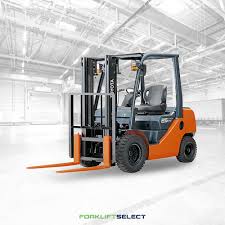Forklifts are one of the most important machines in warehouses, factories, and construction sites. They help lift, move, and stack heavy loads with ease. Over the years, forklift brands have developed machines that are safer, faster, and more efficient. But the world is changing quickly, and so is the forklift industry. The future of forklift brands will be shaped by new technology, smarter designs, and the demand for more sustainable machines.
In this article, we will look at the trends that will define the future of forklift brands and how they will transform the way businesses handle material movement.
Why Forklift Brands Are Evolving
Forklift brands cannot remain the same as they were in the past. The needs of industries are changing, and companies want machines that are safe, eco-friendly, and cost-efficient. Customers are also asking for equipment that can work in tighter spaces, last longer, and require less repair. To keep up with these demands, forklift brands are focusing on innovation and smart technology.
The evolution of forklift brands is not just about building stronger machines. It is about designing equipment that matches the future of logistics, construction, and supply chains.
Trend 1: Electric Forklifts Taking the Lead
One of the most important trends for forklift brands is the move from diesel and gas engines to electric power. Electric forklifts are quieter, cleaner, and easier to maintain. Companies that want to reduce fuel costs and meet environmental rules are now choosing electric options.
In the future, forklift brands will continue to design electric forklifts with longer battery life and faster charging. Some brands are even exploring solar-powered charging systems to make the machines more sustainable. This trend shows that electric forklifts are not just a passing idea but the main choice for tomorrow.
Trend 2: Smarter and More Connected Machines
Technology is changing everything, and forklifts are no exception. Forklift brands are now adding smart features to their machines. These include sensors, cameras, and data systems that allow operators and managers to track performance in real time.
For example, smart systems can show when a forklift needs service before it breaks down. Cameras and sensors can improve safety by reducing accidents in busy warehouses. In the coming years, forklift brands will focus more on connected machines that talk to each other and share information with managers. This makes work safer and more efficient.
Trend 3: Automation and Driverless Forklifts
Another trend that is shaping forklift brands is automation. Many industries are looking for driverless forklifts that can move goods without human operators. These machines use sensors, artificial intelligence, and mapping systems to move safely inside a warehouse or factory.
Driverless forklifts can work around the clock without breaks, which increases productivity. While human operators will still be important, forklift brands will continue to create automated solutions that help businesses save time and labor costs.
Trend 4: Sustainability and Green Practices
Sustainability is no longer just a choice; it is a requirement. Forklift brands are working on reducing their carbon footprint by using eco-friendly materials and energy-saving designs. Electric forklifts are part of this trend, but there is more to come.
For example, future forklift brands may use recyclable parts, energy-efficient motors, and even hydrogen fuel cells. This move toward green machines will not only help the environment but also lower long-term costs for businesses that use them.
Trend 5: Improved Safety Features
Safety has always been important in forklifts, and it will be even more important in the future. Forklift brands are adding advanced safety features such as automatic braking, warning alarms, and stability control.
In the future, these machines may have artificial intelligence systems that can detect hazards and react faster than a human operator. With these improvements, forklift brands will help reduce workplace accidents and protect both workers and products.
Trend 6: Compact and Flexible Designs
Space in warehouses and factories is becoming more limited. This means forklift brands will need to design compact machines that can work in tight spaces. Smaller forklifts with the same power as larger ones will be in demand.
In addition, flexible designs that allow forklifts to switch between tasks will become popular. For example, a forklift that can both lift pallets and handle unusual loads will save money and space for businesses.
Trend 7: Focus on Operator Comfort
Even as automation grows, human operators will continue to play a role in forklift operations. Forklift brands are paying more attention to operator comfort. This includes designing cabins with better visibility, comfortable seats, and easy-to-use controls.
In the future, we may see forklifts with features like climate control, touch-screen panels, and even voice commands. These improvements will make operators more productive and reduce fatigue during long shifts.
Trend 8: Data-Driven Maintenance
Downtime is one of the biggest problems in forklift operations. If a machine breaks down, work slows down and costs increase. Forklift brands are now using technology to predict when maintenance is needed.
Future forklifts will come with built-in systems that monitor the health of the machine. These systems will alert managers before a breakdown happens, allowing quick repairs. This trend of predictive maintenance will save time, reduce costs, and increase the lifespan of forklifts.
Trend 9: Global Expansion and Customization
As industries grow around the world, forklift brands will expand their reach to serve new markets. Companies will look for machines that are customized to their needs, whether it is a large construction site or a small warehouse.
This means forklift brands will not just create one-size-fits-all machines. Instead, they will offer models that can be adjusted to meet different customer needs. Customization will become a major trend in the future of forklift brands.
Trend 10: Training and Skill Development
As forklifts become more advanced, operators will need more training to use them effectively. Forklift brands will play a role in offering training programs that teach workers how to use new technology.
In the future, training may include virtual reality simulations, online lessons, and hands-on practice. Skilled operators will be able to get the most out of modern forklifts, making businesses more efficient and safe.
Why These Trends Matter
The future of forklift brands is not only about making stronger machines but also about creating equipment that matches the needs of a modern world. Trends such as electric power, automation, sustainability, and smart technology will shape the future of logistics and material handling.
By watching these trends closely, businesses can prepare for the future and choose forklift brands that help them save time, reduce costs, and work safely.
Conclusion
Forklift brands are at an exciting point in history. The machines of the future will be electric, smart, automated, safe, and eco-friendly. Compact designs, better operator comfort, and predictive maintenance will make them even more useful.



